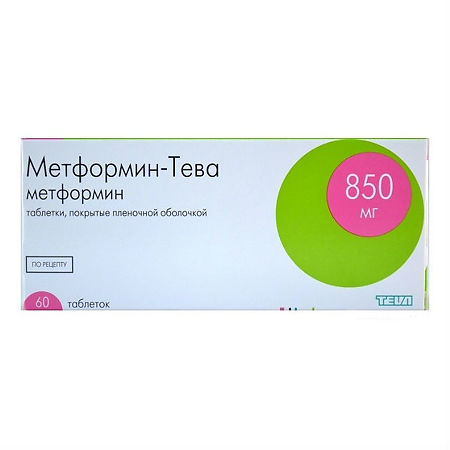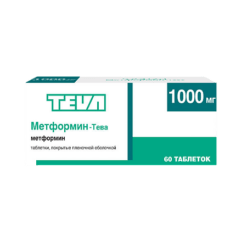No products in the cart.
Metformin-Teva, 850 mg 60 pcs
€1.00
Out of stock
(E-mail when Stock is available)
Description
Metformin has hypoglycemic effect.
Pharmacodynamics
Metformin is an oral hypoglycemic agent of biguanide group. In patients with diabetes it decreases the concentration of glucose in blood by inhibiting gluconeogenesis in the liver, reducing the absorption of glucose from the gastrointestinal tract (GIT) and increasing its utilization in tissues by increasing their sensitivity to insulin (mainly in transverse striated musculature and to a lesser extent in adipose tissue).
It does not stimulate insulin secretion and does not cause hypoglycemic reactions. It influences lipid metabolism – decreases the concentration in the blood serum of triglycerides, cholesterol and low-density lipoproteins. Stimulates intracellular glycogenesis by activating glycogen synthase.
Pharmacokinetics
Intake
After oral administration metformin is fairly completely absorbed from the gastrointestinal tract. Absolute bioavailability is 50-60%. Maximal concentration (Cmax) in plasma is approximately 2 µg/ml or 15 µmol/L and is reached after 2.5 hours. After 7 hours, absorption from the gastrointestinal tract ends, and plasma concentration of metformin gradually decreases. When concomitant intake of food, absorption of metformin is reduced and slows down.
Distribution
Metformin is almost not bound to plasma proteins and is rapidly distributed to body tissues. It penetrates red blood cells. It accumulates in the salivary glands, liver and kidneys. The apparent volume of distribution is 63-276 liters.
Metabolism and excretion
Excreted by the kidneys unchanged. Clearance of metformin in healthy subjects is 400 ml/min, indicating active glomerular filtration and tubular secretion. The elimination half-life (T1/2) is approximately 6.5 h.
Pharmacokinetics in special clinical cases
In patients with renal impairment, metformin renal clearance decreases in proportion to decreased creatinine clearance, T1/2 increases, resulting in increased metformin blood concentrations. Cumulation is possible.
Indications
Indications
Type 2 diabetes mellitus in adults (especially in obese patients) when diet and exercise are ineffective as monotherapy or in combination with other oral hypoglycemic agents or insulin.
Pharmacological effect
Pharmacological effect
Metformin has a hypoglycemic effect.
Pharmacodynamics
Metformin is an oral hypoglycemic agent from the biguanide group. In patients with diabetes mellitus, it reduces the concentration of glucose in the blood by inhibiting gluconeogenesis in the liver, reducing the absorption of glucose from the gastrointestinal tract (GIT) and increasing its utilization in tissues by increasing their sensitivity to insulin (mainly striated muscles, to a lesser extent adipose tissue).
Does not stimulate insulin secretion and does not cause hypoglycemic reactions. It has an effect on lipid metabolism – it reduces the concentration of triglycerides, cholesterol and low-density lipoproteins in the blood serum. Stimulates intracellular glycogenesis by activating glycogen synthase.
Pharmacokinetics
Suction
After taking the drug orally, metformin is quite completely absorbed from the gastrointestinal tract. Absolute bioavailability is 50-60%. The maximum concentration (Cmax) in plasma is approximately 2 µg/ml or 15 µmol/l and is achieved after 2.5 hours. After 7 hours, absorption from the gastrointestinal tract ends and the concentration of metformin in plasma gradually decreases. With simultaneous food intake, the absorption of metformin is reduced and slowed down.
Distribution
Metformin practically does not bind to plasma proteins and is quickly distributed into body tissues. Penetrates into red blood cells. Accumulates in the salivary glands, liver and kidneys. The apparent volume of distribution is 63-276 l.
Metabolism and excretion
It is excreted unchanged by the kidneys. The clearance of metformin in healthy individuals is 400 ml/min, which indicates active glomerular filtration and tubular secretion. The half-life (T1/2) is approximately 6.5 hours.
Pharmacokinetics in special clinical situations
In patients with renal failure, the renal clearance of metformin decreases in proportion to the decrease in creatinine clearance, T1/2 increases, which leads to an increase in the concentration of metformin in the blood. Cumulation is possible.
Special instructions
Special instructions
During treatment with Metformin-Teva, it is necessary to regularly monitor the concentration of glucose in the blood on an empty stomach and after meals.
The patient should be warned about the need to stop taking the drug and consult a doctor if vomiting, abdominal pain, muscle pain, general weakness and severe malaise occur. These symptoms may be a sign of incipient lactic acidosis. Metformin-Teva should be discontinued 48 hours before and 48 hours after an X-ray examination (including urography, intravenous angiography) using radiocontrast agents.
Metformin-Teva should be discontinued 48 hours before and 48 hours after surgery under general anesthesia, spinal or epidural anesthesia. Since metformin is excreted by the kidneys, CK should be determined before starting treatment and regularly thereafter: in patients with preserved renal function once a year, in patients with reduced CK and in elderly patients 2-4 times a year.
Particular caution should be exercised if renal function is impaired, for example, during the initial period of therapy with antihypertensive drugs, diuretics, NSAIDs.
The patient should be informed about the need to consult a doctor if symptoms of a bronchopulmonary infection or infectious disease of the genitourinary organs appear. While using the drug Metformin-Teva, you should refrain from drinking alcohol, due to the increased risk of developing hypoglycemia and a disulfiram-like effect. Hypovitaminosis B12 when taking the drug Metformin-Teva is caused by impaired absorption of vitamin B12 and is reversible. When the drug Metformin-Teva is discontinued, the signs of hypovitaminosis B12 quickly disappear.
Active ingredient
Active ingredient
Metformin
Composition
Composition
Active ingredient:
metformin hydrochloride 850 mg;
Excipients:
povidone K30;
povidone K90;
colloidal silicon dioxide;
magnesium stearate;
shell Opadry white Y-1-7000H (hypromellose (E464);
titanium dioxide (E171);
macrogol 400
Contraindications
Contraindications
Hypersensitivity to metformin or to any excipient of the drug.
Diabetic ketoacidosis, diabetic precoma, coma.
Renal failure or impaired renal function (creatinine clearance (CC) less than 60 ml/min).
Acute conditions that occur with a risk of developing renal dysfunction: dehydration (with diarrhea, vomiting), fever, severe infectious diseases, hypoxia conditions (shock, sepsis, kidney infections, bronchopulmonary diseases).
Clinically pronounced manifestations of acute and chronic diseases that can lead to the development of tissue hypoxia (including cardiac OR respiratory failure, acute myocardial infarction).
Major surgical operations and injuries when insulin therapy is indicated (see section “Special Instructions”).
Liver failure, liver dysfunction.
Chronic alcoholism, acute alcohol poisoning.
Lactic acidosis (including history).
Use for at least 48 hours before and for 48 hours after radioisotope or x-ray studies with the introduction of an iodine-containing contrast agent (see section “Interaction with other drugs”).
A period of at least 48 hours before and 48 hours after surgical interventions under general anesthesia, spinal or epidural anesthesia.
Following a hypocaloric diet (less than 1000 kcal/day).
Children under 18 years of age.
With caution: in persons over 60 years of age who perform heavy physical work (increased risk of developing lactic acidosis).
Side Effects
Side Effects
From the central nervous system: often – taste disturbance (metallic taste in the mouth).
From the digestive system: very often – nausea, vomiting, abdominal pain, lack of appetite, which occur during the initial period of treatment and in most cases disappear spontaneously; isolated cases – impaired liver function tests or hepatitis, which completely disappear after discontinuation of the drug.
Allergic reactions: very rarely – erythema, itching, rash.
Metabolism: very often – lactic acidosis (requires discontinuation of the drug).
Other: very rarely – with prolonged use, hypovitaminosis B12 develops.
Interaction
Interaction
Not recommended combinations
When metformin is used simultaneously with danazol, a hyperglycemic effect may develop. If treatment with danazol is necessary and after stopping its use, a dose adjustment of metformin under glycemic control is required. With the simultaneous use of metformin with alcohol and ethanol-containing drugs, the risk of developing lactic acidosis during acute alcohol intoxication increases, especially during fasting or following a low-calorie diet, as well as in liver failure.
Combinations requiring special care
Chlorpromazine in high doses (100 mg/day) reduces insulin release and increases blood glucose concentrations. When used simultaneously with antipsychotics and after stopping their use, dose adjustment of metformin under glycemic control is required. Glucocorticosteroids (GCS) reduce glucose tolerance and increase blood glucose concentrations, in some cases causing ketosis. If it is necessary to use such a combination and after discontinuation of GCS, a dose adjustment of metformin under glycemic control is required.
With the simultaneous use of loop diuretics and metformin, there is a risk of developing lactic acidosis due to the possible occurrence of functional renal failure.
Radiological examination with the use of iodine-containing radiocontrast agents can cause the development of lactic acidosis in patients with diabetes mellitus against the background of functional renal failure. The use of metformin should be discontinued 48 hours before and not resumed until 48 hours after an X-ray examination using radiocontrast agents.
The administration of beta2-adrenergic agonists by injection reduces the hypoglycemic effect of metformin due to stimulation of beta2-adrenergic receptors. In this case, you should monitor the concentration of glucose in the blood and, if necessary, prescribe insulin. Angiotensin-converting enzyme inhibitors and other antihypertensive drugs may decrease blood glucose concentrations. If necessary, the dose of metformin should be adjusted.
With simultaneous use of metformin with sulfonylurea derivatives, insulin, acarbose and salicylates, the hypoglycemic effect may be enhanced. Loop diuretics and nonsteroidal anti-inflammatory drugs (NSAIDs) increase the risk of decreased kidney function. In this case, caution must be exercised when using metformin.
Overdose
Overdose
Symptoms: When using metformin at a dose of 85 g, no hypoglycemia was observed, but the development of lactic acidosis was noted. Early symptoms of lactic acidosis are nausea, vomiting, diarrhea, decreased body temperature, abdominal pain, muscle pain, and later rapid breathing, dizziness, impaired consciousness and the development of coma may occur.
Treatment: If signs of lactic acidosis appear, treatment with the drug must be stopped immediately, the patient must be urgently hospitalized and, having determined the lactate concentration, the diagnosis must be clarified. The most effective measure for removing lactate and metformin from the body is hemodialysis. Symptomatic treatment is also carried out.
Storage conditions
Storage conditions
At a temperature not exceeding 25 °C
Shelf life
Shelf life
3 years
Manufacturer
Manufacturer
Teva Czech Enterprises s.r.o., Czech Republic
Additional information
| Shelf life | 3 years |
|---|---|
| Conditions of storage | At a temperature not exceeding 25 °C |
| Manufacturer | Teva Czech Enterprises s.r.o., Czech Republic |
| Medication form | pills |
| Brand | Teva Czech Enterprises s.r.o. |
Other forms…
Related products
Buy Metformin-Teva, 850 mg 60 pcs with delivery to USA, UK, Europe and over 120 other countries.















